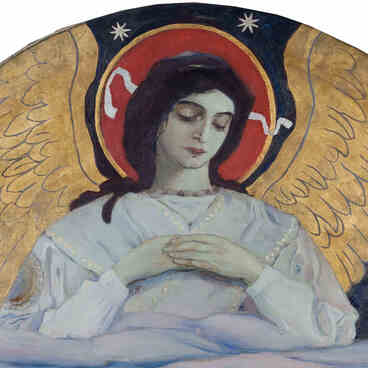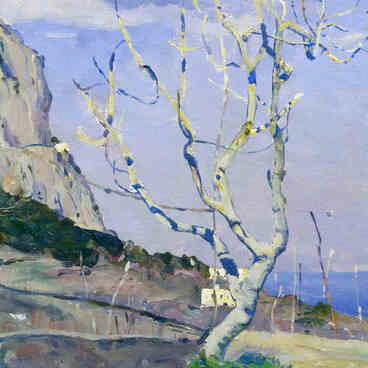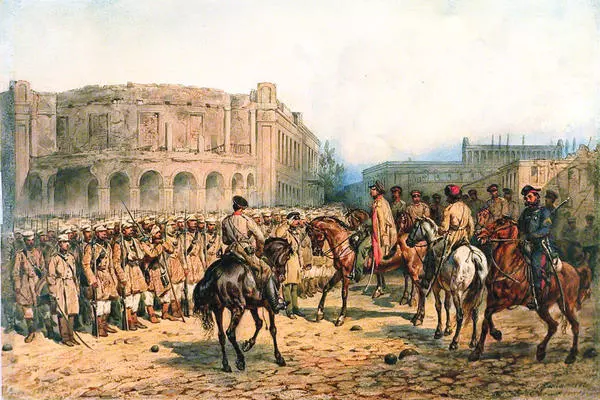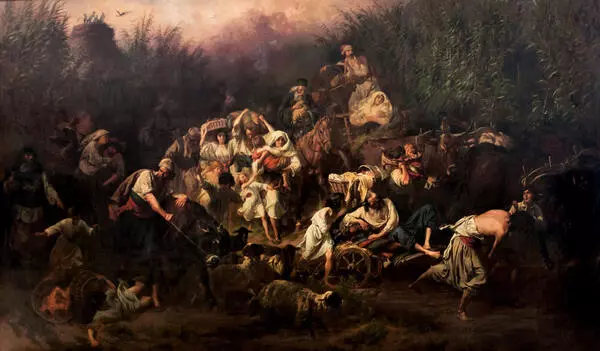One of the most interesting works presented in the collection of the Nikolai Golovanov Apartment Museum is the painting “Araba in the North Caucasus” by Konstantin Filippov.
The battle painter Konstantin Nikolayevich Filippov studied in the studio of the artist Bogdan Willewalde at the Imperial Academy of Arts. He received many medals for his student works. When the Crimean War started, Filippov, still a student at the Academy, was sent to the Russian army to sketch episodes of battles and create studies of military scenes. Filippov received the Big Gold Medal for the painting “The Military Road Between Sevastopol and Simferopol in the Time of the Crimean War” (the work is housed in the Tretyakov Gallery). After graduating from the Academy of Arts, the artist left for Warsaw to work on battle compositions commissioned by the Viceroyalty of the Kingdom of Poland. In 1859, Filippov earned a subsidized trip from the Academy to go abroad. At first, he lived and worked in Rome, and then continued to hone his skills in Paris. Konstantin Filippov also worked in the North Caucasus, under the Caucasian governor. In 1865, he was granted the title of academician for his work “The Flight of Bulgarians from the Danube River following the Russian Army Retreat from Silistra”. He published his battle sketches in the magazine “Russky khudozhestvenny listok” (Russian Art Newsletter).
Between 1871 and 1873, Filippov used watercolors and oil paints to depict episodes from the travels of Emperor Alexander II in the Caucasus. The artist spent the last years of his life in Crimea. Nikolai Golovanov’s collection had only one piece by this remarkable battle painter, which is currently located in the musician’s study. It is worth mentioning that Filippov’s paintings often feature scenes of river crossings, rural life and battles, for example, “In the Caucasus Mountains” (1864), “Rural Scene in Caucasia”, and “Courier Riding in a Troika in the Caucasus” (1871). The works of Konstantin Filippov are housed in many museums, including the State Tretyakov Gallery, the State Russian Museum and others.
The battle painter Konstantin Nikolayevich Filippov studied in the studio of the artist Bogdan Willewalde at the Imperial Academy of Arts. He received many medals for his student works. When the Crimean War started, Filippov, still a student at the Academy, was sent to the Russian army to sketch episodes of battles and create studies of military scenes. Filippov received the Big Gold Medal for the painting “The Military Road Between Sevastopol and Simferopol in the Time of the Crimean War” (the work is housed in the Tretyakov Gallery). After graduating from the Academy of Arts, the artist left for Warsaw to work on battle compositions commissioned by the Viceroyalty of the Kingdom of Poland. In 1859, Filippov earned a subsidized trip from the Academy to go abroad. At first, he lived and worked in Rome, and then continued to hone his skills in Paris. Konstantin Filippov also worked in the North Caucasus, under the Caucasian governor. In 1865, he was granted the title of academician for his work “The Flight of Bulgarians from the Danube River following the Russian Army Retreat from Silistra”. He published his battle sketches in the magazine “Russky khudozhestvenny listok” (Russian Art Newsletter).
Between 1871 and 1873, Filippov used watercolors and oil paints to depict episodes from the travels of Emperor Alexander II in the Caucasus. The artist spent the last years of his life in Crimea. Nikolai Golovanov’s collection had only one piece by this remarkable battle painter, which is currently located in the musician’s study. It is worth mentioning that Filippov’s paintings often feature scenes of river crossings, rural life and battles, for example, “In the Caucasus Mountains” (1864), “Rural Scene in Caucasia”, and “Courier Riding in a Troika in the Caucasus” (1871). The works of Konstantin Filippov are housed in many museums, including the State Tretyakov Gallery, the State Russian Museum and others.





